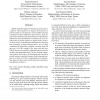Free Online Productivity Tools
i2Speak
i2Symbol
i2OCR
iTex2Img
iWeb2Print
iWeb2Shot
i2Type
iPdf2Split
iPdf2Merge
i2Bopomofo
i2Arabic
i2Style
i2Image
i2PDF
iLatex2Rtf
Sci2ools
89
Voted
IPPS
2005
IEEE
2005
IEEE
FROST: Revisited and Distributed
FROST (Fold Recognition-Oriented Search Tool) [6] is a software whose purpose is to assign a 3D structure to a protein sequence. It is based on a series of filters and uses a database of about 1200 known 3D structures, each one associated with empirically determined score distributions. FROST uses these distributions to normalize the score obtained when a protein sequence is aligned with a particular 3D structure. Computing these distributions is extremely time consuming; it requires solving about 1, 200, 000 hard combinatorial optimization problems and takes about 40 days on a 2.4 GHz computer. This paper describes how FROST has been successfully redesigned and structured in modules and independent tasks. The new package organization allows these tasks to be distributed and executed in parallel using a centralized dynamic load balancing strategy. On a cluster of 12 PCs, computing the score distributions takes now about 3 days which represents a paralleliza
3d Structure | Distributed And Parallel Computing | IPPS 2005 | Protein Sequence | Score Distributions |
Related Content
| Added | 25 Jun 2010 |
| Updated | 25 Jun 2010 |
| Type | Conference |
| Year | 2005 |
| Where | IPPS |
| Authors | Vincent Poirriez, Rumen Andonov, Antoine Marin, Jean-François Gibrat |
Comments (0)

